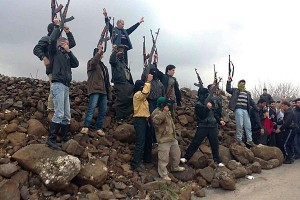Special to WorldTribune.com
LONDON — The Syrian rebel movement, after more than six months of
fighting, remains without a chain of command.
A leading Middle East analyst who visited rebel strongholds said the
Free Syrian Army remains collection of separate cells around Syria.
Jonathan Spyer, an Israeli-based analyst who spent several days with FSA,
said the rebels were united only by the desire to overthrown President
Bashar Assad.

“The presence of Iranian officers alongside Assad’s forces is one of the
most noteworthy elements of the regime’s attempt to suppress the Syrian
revolution, and it is a matter of particular anger to the insurgents,” Spyer
said.
Syrian military deserters told Spyer that they had joined the FSA after
refusing orders to fire on civilians. The deserters said Iranian Army
units were serving with Assad forces and firing on Syrian soldiers who
disobeyed orders.
“A united, countrywide armed resistance movement does not yet exist in Syria,” Spyer said in an analysis. “Nor do the rebels possess a single, uniting political idea, beyond bringing down the dictatorship.”
Spyer said FSA commander Col. Riad Assad is not seen as the leader of the rebellion. He said the Sunni revolt was fueled by the desire to protect the majority community against attacks by the Assad regime.
“In the course of my time there, I met not a single fighter or officer
who considered Col. Riad Assad, the nominal head of the FSA who is based in Antalya, Turkey, to constitute the real directing hand of the movement,” Spyer said on Feb. 21.
FSA claims a membership of some 40,000 fighters, more than half of them deserters from the Syrian Army. Spyer, who arrived from neighboring Turkey and spent most of his time in the Idlib province in northwestern Syria, said
FSA as well as local militias have taken over parts of the province.
“It [FSA] isn’t really an organization at all,” Spyer, a senior fellow
at Israel’s Gloria Center, said. “It consists of a series of local armed
initiatives centered around strongmen of various political orientations.
These militias operate according to their own perceived needs, mainly seeing
their job as protecting the precarious autonomous zones carved out from the
Assad regime in Idlib, Homs, and other areas in the course of the uprising.”
Spyer said FSA was represented by Salafists, the doctrine of Wahabi
Islam, particularly in Idlib. But he said the Salafists do not dominate FSA.
“But the overwhelming characteristic of the FSA is that it is Sunni,”
Spyer said. “There is an unmistakable and strong sectarian element in the
revolt against the Assad regime, even though this is something that FSA
fighters and opposition activists prefer not to emphasize in front of
visitors. They do not wish to be seen as a sectarian militia, but rather as
an organization battling a dictatorship.”
Spyer said FSA has been lobbying the international community to
establish a buffer zone as well as a no-fly zone. He said without
international intervention the Assad regime could survive for months or
years. On Feb. 29, however, an FSA commander said the rebel force has
received anti-aircraft missiles from France.
“At the moment, the FSA has AK-47s, RPG-7s, heavy machine guns, and
some mortars,” Spyer said. “They will need more than this to face down an assault
from Assad’s Russian-supplied, modern weaponry.”

You must be logged in to post a comment Login